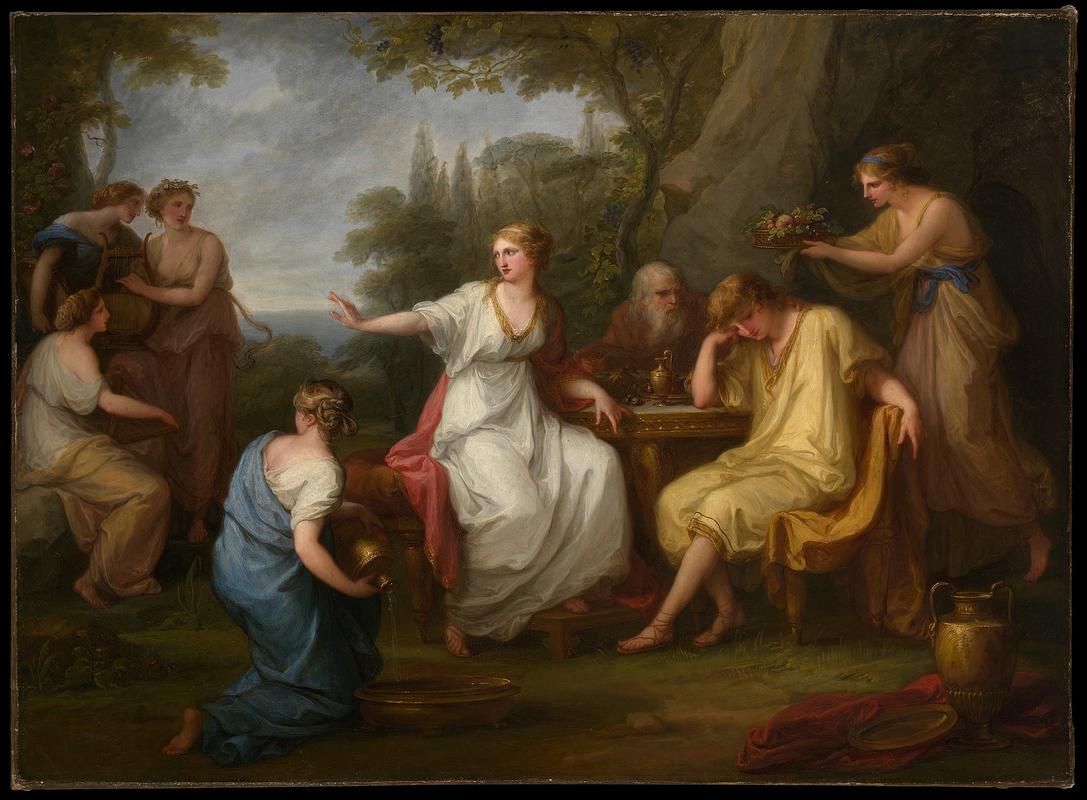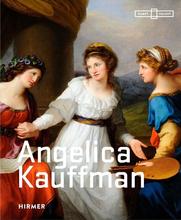More about The Sorrow of Telemachus
- All
- Info
- Shop

Sr. Contributor
While Telemachus’s dad Odysseus just didn’t seem to want to be found, Angelica Kauffman’s father encouraged the aspiring young artist to find herself.
Angelica Kauffman grew up during the Enlightenment. Despite being the Age of Reason, women were made to believe that their only stations in life were to be mothers and family caretakers. Women weren’t supposed to work – much less gallivant around Europe and become famous Neoclassical artists, but what can you do? Because her father was an artist who encouraged Angelica’s own artistic career, she had opportunities that virtually no other female artist did during this time, like the ability to privately copy masterworks in a special room at the Uffizi Gallery.
While traveling around Europe with her dad, Angelica saw the treasures of Greek and Roman antiquity, as well as the masterworks of Renaissance Italy. These experiences inspired her to join the ranks of the first generation of European Neoclassical painters. However, Angelica couldn’t just jump into this realm of the fine arts. She got her start with a little help from some friends. To start her career, a wealthy Englishwoman brought little Angelica to England to make it as a painter. She worked her butt off and painted enough society portraits in one year to gain artistic success and, more importantly, financial independence. She then upped her game with mythological subject matter.
But not everyone was on board with the new girl in town. After becoming good friends with fellow painter Joshua Reynolds, rumors circulated about the nature of their friendship. You know how those English love to gossip. John Constable particularly did not like Angelica. He was not amused with seeing a woman succeed in the art world. He picked on her by calling her decadent, which I guess was the best eighteenth-century insult he could come up with. At any rate, he was just jealous, which was not a good look.
Angelica continued to be a successful painter and moved permanently to Rome in 1782, where she completed The Sorrow of Telemachus. The painting is based on the novel The Adventures of Telemachus, which tells the story of how Odysseus’s son Telemachus went searching for his father. French theologian and political theorist François Fénelon wrote the book in 1699. Fénelon also happened to be the tutor of the seven-year old Duc de Bourgogne, the grandson of the ever-popular Louis XIV. Angelica was one of the only artists to paint scenes from the story of Telemachus. This just goes to show how good she really was.
In addition to being inspired by a well-known book, this painting has also had a series of illustrious owners. This was one of two paintings that Angelica painted for Monsignor Onorato Caetani, who came from a noble Roman family and only commissioned works from the best contemporary artists. You go, girl! Before going to the Met, the painting belonged to the family of Collis Potter Huntington, an American railroad magnate who helped make the Transcontinental Railroad possible. Take that, Constable.
Sources
- Art UK. “Angelica Kauffmann.” Artists. https://artuk.org/discover/artists/kauffmann-angelica-17411807. Accessed November 27, 2017.
- Baetjer, Katharine. British Paintings in The Metropolitan Museum of Art, 1585–1875. New York: The Metropolitan Museum of Art, 2009.
- Davis, Penelope J.E., Frima Fox Hofrichter, Joseph Jacobs, Ann M. Roberts, and David L. Simon. Janson’s Basic History of Western Art. 8th edition. Upper Saddle River, NJ: Pearson Education, Inc., 2009.
- Gontar, Cybele. “Neoclassicism.” The Heilbrunn Timeline of Art History. The Metropolitan Museum of Art. October 2003. https://www.metmuseum.org/toah/hd/neoc_1/hd_neoc_1.htm. Accessed November 27, 2017.
- Liechtenstein, The Princely Collections. “Angelica Kauffmann, Telemachus and Mentor on the Island of Calypso.” Liechtenstein, The Princely Collections. http://www.liechtensteincollections.at/en/pages/artbase_main.asp?module…
- McDowall, Carolyn. “Angelica Kauffmann Artist – A Woman of Influence & Style.” The Culture Concept Circle. April 7, 2013. https://www.thecultureconcept.com/angelica-kauffmann-artist-a-woman-of-…. Accessed November 19, 2017.
- National Museum of Women in the Arts. “Angelica Kauffmann.” Artist Profiles. https://nmwa.org/explore/artist-profiles/angelica-kauffman. Accessed November 27, 2017.
- The Editors of Encyclopaedia Britannica. “Collis P. Huntington, American Railroad Magnate.” Biography. Encyclopaedia Britannica. https://www.britannica.com/biography/Collis-P-Huntington. Accessed November 27, 2017.
- The Guerrilla Girls. The Guerrilla Girls’ Bedside Companion to the History of Western Art. New York: Penguin Books, 1998.
- The Metropolitan Museum of Art. “The Sorrow of Telemachus.” Collection. The Metropolitan Museum of Art, https://www.metmuseum.org/art/collection/search/436809. Accessed November 27, 2017.
- Wikipedia. “Les Aventures de Telemaque.” Wikipedia. https://en.wikipedia.org/wiki/Les_Aventures_de_T%C3%A9l%C3%A9maque. Accessed November 27, 2017.

Contributor
Here we see Angelica Kauffman’s depiction of the moment in which the cunning Calypso meets Telemachus.
It’s from a novel called Les Aventures de Télémaque, which is based off the epic Greek poem the Odyssey. Just moments earlier, Telemachus, the solemn looking fellow in the front, washed up on the land of Ogygia after his ship wrecked off the coast. With Telemachus is his companion Mentor, the older gentleman in the background, who looks a bit aged to be engaging in antics such as sailing around the world and mingling with sexy nymphs.
Life has been hard on Telemachus recently. His father, Odysseus, has been missing for twenty years and feeling the strain of having no daddy figure in his life, Telemachus has departed on a journey to find him. Clearly experiencing a bout of bad luck, or lacking in the nautical skills necessary for such a journey, these two end up ruining their ship and find themselves in the clutches of the tantalizing Calypso.
Calypso clearly has a hankering for Telemachus’ gene pool, for she had recently fallen deeply in love with Odysseus. Being the perverted little stalker she was, she decided to hold Odysseus hostage for seven years, enticing him with her fresh dance moves and her exquisite ability to weave on a loom. Sadly for her, Zeus demanded that she let Odysseus go free.
In this painting, we see Calypso trying to comfort the forlorn Telemachus while she shuns her nymphs for trying to serenade the newcomers. She likely didn’t have the heart to tell him that she was part of the reason he was dad-less.
Featured Content
Here is what Wikipedia says about The Sorrow of Telemachus
The Sorrow of Telemachus is a 1783 oil painting by the Swiss artist Angelica Kauffman. It is in the collection of the Metropolitan Museum of Art.
Check out the full Wikipedia article about The Sorrow of Telemachus













